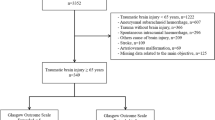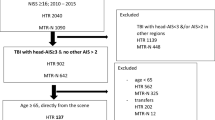Abstract
Traumatic brain injury (TBI) in older adults is an increasing issue in modern medicine. Nevertheless, it remains unclear which patients presenting with TBI and 80 years of age or older benefit from an operative treatment. The aim of this study was to explore the effect of an operative treatment in isolated TBI patients ≥ 80 years of age. Data were derived from the TraumaRegister DGU® from 2002 to 2016. Inclusion criteria were ≥ 80 years of age, an Abbreviated Injury ScaleHead (AIS) ≥ 3, and an AISNon-Head ≤ 1. The cohort was split in operatively and non-operatively treated patients, and outcome was assessed at discharge using the Glasgow Outcome Scale (GOS). A favorable outcome was defined as a GOS of 4 or 5. A total of 1.693 patients (431 operatively and 1.262 non-operatively treated patients) were analyzed. Mortality rate was 54.4% (687 patients) in the non-operative group and 49.4% in the operative group. Simultaneously, there were more patients discharged with a GOS 2 (persistent vegetative state) in the operative group (7.9%, 34 patients) than in the non-operative group (1.0%, 13 patients). An analysis of the operatively treated patients showed an association between a higher mortality risk and brainstem hemorrhage (p = 0.04), fixed pupils (p = 0.001), initial intubation (p = 0.03), and an AISHead of 5/6 (p = 0.03). Patients 80 years of age or older seem to benefit from an operative treatment regarding mortality rate. However, there has been a higher rate of a poor neurological outcome particularly with regard to persistent vegetative state in the operative treatment group at discharge.

Similar content being viewed by others
References
Brazinova A, Mauritz W, Leitgeb J, Wilbacher I, Majdan M, Janciak et al (2010) Outcomes of patients with severe traumatic brain injury who have a Glasgow Coma scale scores of 3 or 4 and are over 65 years old. J Neurotrauma 27:1549–1555
Bus S, Verbaan D, Kerklaan BJ, Sprengers MES, Vandertop WP, Stam J, Bouma GJ, van den Munckhof P (2019) Do older patients with acute or subacute subdural hematoma benefit from surgery? Br J Neurosurg 33:51–57
Cooper DJ, Rosenfeld JV, Murray L, Arabi YM, Davies AR, D’Urso P et al (2011) Decompressive craniectomy in diffuse traumatic brain injury. N Engl J Med 364:1493–1502
De Bonis P, Pompucci A, Mangiola A, Paternoster G, Festa R, Nucci CG et al (2011) Decompressive craniectomy for elderly patients with traumatic brain injury: it’s probably not worth the while. J Neurotrauma 28:2043–2048
Emami P, Czorlich P, Fritzsche FS, Westphal M, Rueger JM, Lefering R, Hoffmann M (2017) Impact of Glasgow Coma Scale score and pupil parameters on mortality and outcome in pediatric and adult severe traumatic brain injury: a retrospective, multicenter cohort study. J Neurosurg 126:760–767
Gardner RC, Dams-O’Connor K, Morissey MR, Manley GT (2018) Geriatric traumatic brain injury: epidemiology, outcomes, knowledge gaps, and future directions. J Neurotrauma 35:889–906. https://doi.org/10.1089/neu.2017.5371
Haasper C, Junge M, Ernstberger A, Brehme H, Hannawald L, Langer C, Nehmzow J, Otte D, Sander U, Krettek C, Zwipp H (2010) The Abbreviated Injury Scale (AIS). Options and problems in application. Unfallchirurg 113:366–372 [in German]
Hawley C, Sakr M, Scapinello S, Salvo J, Wrenn P (2017) Traumatic brain injuries in older adults – 6 years of data for one UK trauma centre: retrospective analysis of prospectively collected data. Emerg Med J 34:509–516
Hukkelhoven CW, Steyerberg EW, Rampen AJ, Farace E, Habbema JD, Marshall LF et al (2003) Patient age and outcome following severe traumatic brain injury: an analysis of 5600 patients. J Neurosurg 99:666–673
Hutchinson PJ, Kolias AG, Timofeev IS, Corteen EA, Czosnyka M, Timothy J, Anderson I, Bulters DO, Belli A, Eynon CA, Wadley J, Mendelow AD, Mitchell PM, Wilson MH, Critchley G, Sahuquillo J, Unterberg A, Servadei F, Teasdale GM, Pickard JD, Menon DK, Murray GD, Kirkpatrick PJ, RESCUEicp Trial Collaborators (2016) Trial of decompressive craniectomy for traumatic intracranial hypertension. N Engl J Med 375:1119–1130
Jennett B, Bond M (1975) Assessment of outcome after severe brain damage. Lancet 1:480–484
Lefering R, Huber-Wagner S, Nienaber U, Maegele B, Bouillon B (2014) Update of the trauma risk adjustment model of the TraumaRegister DGU®: the Revised Injury Severity Classification, version II. Crit Care 18:476. https://doi.org/10.1186/s13054-014-0476-2
Lilley EJ, Williams KJ, Schneider EB, Hammouda K, Salim A, Haider AD et al (2016) Intensity of treatment, end-of-life care, and mortality for older patients with severe traumatic brain injury. J Trauma Acute Care Surg 80:998–1004
Luerssen TG, Klauber MR, Marshall LF (1988) Outcome from head injury related to patient’s age. A longitudinal study of adult and pediatric head injury. J Neurosurg 68:409–416
Marquez de la Plata CD, Hart T, Hammond FM, Frol AB, Hudak A, Harper CR, O'Neil-Pirozzi TM, Whyte J, Carlile M, Diaz-Arrastia R (2008) Impact of age on long-term recovery from traumatic brain injury. Arch Phys Med Rehabil 89:896–903
McIntyre A, Mehta S, Aubut J, Dijkers M, Teasell RW (2013) Mortality among older adults after a traumatic brain injury: a meta-analysis. Brain Inj 27:31–40
Mushkudiani NA, Engel DC, Steyerberg EW, Butcher I, Lu J, Marmarou A, Slieker F, McHugh GS, Murray GD, Maas AIR (2007) Prognostic value of demographic characteristics in traumatic brain injury: results from the IMPACT study. J Neurotrauma 24:259–269
Parehk AK, Barton MB (2010) The challenge of multiple comorbidity for the US health care system. JAMA 303:1303–1304
Peeters W, van den Brande R, Polinder S, Brazinova A, Steyerberg EW, Lingsma HF, Maas AIR (2015) Epidemiology of traumatic brain injury in Europe. Acta Neurochir (Wien) 157:1683–1696
Pompucci A, De Bonis P, Pettorini B, Petrella G, Di Chirico A, Anile C (2007) Decompressive craniectomy for traumatic brain injury: patient and outcome. J Neurotrauma 24:1182–1188
Rickels E, von Wild K, Wenzlaff P (2010) Head injury in Germany: a population based-prospective study in epidemiology, causes, treatment and outcome of all degrees of head-injury severity in two distinct areas. Brain Inj 24:1491–1504
Rosenfeld JV, Tee JW (2015) How aggressively should neurosurgeons treat elderly patients with severe blunt traumatic brain injury? Injury 46:1703–1705
Rosenørn J, Gjerris F (1978) Long-term follow-up review of patients with acute and subacute subdural hematomas. J Neurosurg 48:345–349
Roozenbeek B, Maas AI, Menon DK (2013) Changing patterns in the epidemiology of traumatic brain injury. Nat Rev Neurol 9:231–236
Salottolo K, Levy AS, Slone DS, Mains CW, Bar-Or D (2014) The effect of age on Glasgow Coma Scale score in patients with traumatic brain injury. JAMA Surg 149:727–734
Schumacher R, Müri RM, Walder B (2017) Integrated health care management of moderate to severe TBI in older patients-a narrative review. Curr Neurol Neurosci Rep 17:92. https://doi.org/10.1007/s11910-017-0801.7
Stein DM, Kozar RA, Livingston DH, Luchette F, Adams SD, Agrawal V, Arbabi S, Ballou J, Barraco RD, Bernard AC, Biffl WL, Bosarge PL, Brasel KJ, Cooper Z, Efron PA, Fakhry SM, Hartline CA, Hwang F, Joseph BA, Kurek SJ, Moore FA, Mosenthal AC, Pathak AS, Truitt MS, Yelon JA, AAST Geriatric Trauma/ACS Committee (2018) Geriatric traumatic brain injury-what we know and what we don’t. J Trauma Acute Care Surg 85:788–798
Thompson HJ, Rivara FP, Jurkovich GJ, Wang J, Nathens AB, Mackenzie EJ (2008) Evaluation of the effect of intensity of care on mortality after traumatic brain injury. Crit Care Med 36:282–290
Tokutomi T, Miyagi T, Ogawa T, Ono J, Kawamata T, Sakamoto T, Shigemori M, Nakamura N (2008) Age-associated increase in poor outcomes after traumatic brain injury: a report from the Japan Neurotrauma Data Bank. J Neurotrauma 25:1407–1414
Utomo WK, Gabbe BJ, Simpson PM, Cameron PA (2009) Predictors of in-hospital mortality and 6-month functional outcomes in older adults after moderate to severe traumatic brain injury. Injury 40:973–977
Vollmer DG, Torner JC, Jane JA, Sadovnic B, Charlebois D, Eisenberg HM et al (1996) Age and outcome following traumatic coma: why do older patients fare worse? J Neurosurg 75:S37–S49
Wan X, Liu S, Wang S, Zhang S, Yang H, Ou Y, Zhao M, James L, Shu K, Chen J, Lei T (2016) Elderly patients with severe traumatic brain injury could benefit from surgical treatment. World Neurosurg 89:147–152
Wutzler S, Lefering R, Wafaisade A, Maegele M, Lustenberger T, Walcher F, Marzi I, Laurer H, TraumaRegister DGU (2015) Aggressive operative treatment of isolated blunt traumatic brain injury in the elderly is associated with a favourable outcome. Injury 46:1706–1711
Author information
Authors and Affiliations
Corresponding author
Ethics declarations
Conflict of interest
Rolf Lefering was paid for statistical reviews from European Journal of Trauma. He is employed by the University of Witten/Herdecke which has a service agreement with the AUC/German Society for Trauma Surgery for scientific assistance, annual audit reports, etc. Rolf Lefering received sponsoring from the DFG (Deutsche Forschungsgemeinschaft), BAST (Federal Highway Research Institute of the Federal Republic of Germany), BMBF (Federal Ministry of Education and Research of the Federal Republic of Germany), and several other research foundations. He also received payments for lectures at the KKS Düsseldorf and Frankfurt; and at Mibeg for education in statistics for study nurses, study physicians, and project managers.
All other authors have no conflicts of interest.
Ethical approval/informed consent
This analysis was reported to the local ethic committee (WF-059-18). Informed consent was waived for this kind of study.
Additional information
Publisher’s note
Springer Nature remains neutral with regard to jurisdictional claims in published maps and institutional affiliations.
Rights and permissions
About this article
Cite this article
Czorlich, P., Mader, M.MD., Emami, P. et al. Operative versus non-operative treatment of traumatic brain injuries in patients 80 years of age or older. Neurosurg Rev 43, 1305–1314 (2020). https://doi.org/10.1007/s10143-019-01159-4
Received:
Revised:
Accepted:
Published:
Issue Date:
DOI: https://doi.org/10.1007/s10143-019-01159-4




